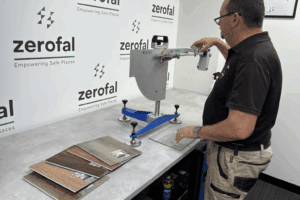Cure Time Matters—Avoid Testing Too Soon
Don’t Let Rushed Testing Cost You Accuracy
Testing a freshly coated or installed surface before it has cured can lead to artificially low slip resistance results. Waiting until the product is fully cured ensures the outcome reflects its real-world performance – and avoids the cost of re-testing.
Slip resistance testing must reflect how a surface will perform in service. One of the most common mistakes is sending samples or booking site tests too soon after coatings, sealants, or adhesives are applied.
Why Cure Time Matters
- Incomplete hardening: Coatings or adhesives that are still curing can be softer or more tacky than intended.
- Surface change over time: As products cure, their hardness, friction, and texture stabilise. Testing early captures only a temporary state.
- Inaccurate classifications: Surfaces tested too soon often produce lower P or D classifications than the same surface once fully cured.
Example
A coating tested at 24 hours returned a P2 rating. The same coating tested after a 7-day cure reached P4, a level suitable for commercial wet areas. The difference was not in the product—but in the timing.
Standards Guidance
- AS 4586:2013 requires that specimens reflect the condition in which they will be used.
- Manufacturers typically recommend 7–14 days curing for coatings before testing.
The Consequences of Testing Too Soon
- Risk of failing certification unnecessarily
- Extra freight and re-testing costs
- Delays to project handover
- Confusion in product specifications
Best Practice
- Always check manufacturer cure times before booking a test.
- Allow adequate curing for coatings, adhesives, or surface treatments.
- If in doubt, confirm with Zerofal before sending samples or scheduling in-situ testing.
Don’t risk a failed result
Book your slip resistance test once your surface is cured and ready. Zerofal can advise on correct timing.
Explore more

Colour, Grit and Surface Finish: How Subtle Differences Change Slip Ratings (AS 4586:2013)
Colour, grit and finish change slip resistance. Learn why P-ratings vary across tile ranges and coatings

Why One Slip Test Isn’t Enough for Product Lines (AS 4586:2013)
Slip resistance varies across colours and finishes. Learn why one AS 4586 test cannot certify an entire product line.

Industrial Slip Resistance: Dust, Boots & Coating Drift (AS 4663:2013)
: Industrial floors change fast. Learn how dust, coatings and machinery reduce slip resistance and why AS 4663 onsite testing is essential.
